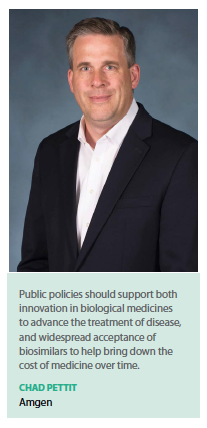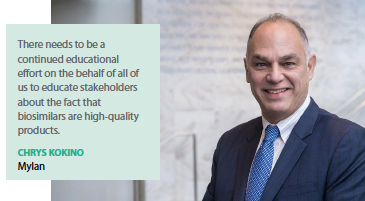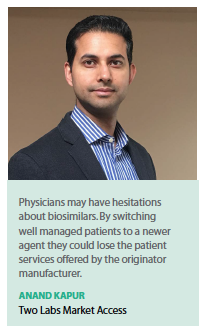While the bulk of activity in the biosimilar space has taken place outside of the United States, the approval and uptake of biosimilars in the United States is expected to pick up over the next five years.
The biosimilar industry has developed rapidly, and regulations have advanced significantly since the early 2000s with approval processes now in place in many countries. With some of the world’s best-known biologics continuing to face patent expiration in the coming years, the biosimilars market is set for continued growth, industry experts say.
Grand View research predicts the global biosimilars market size is expected to reach a value of $61.47 billion by 2025, for a CAGR of 34.2%.
By 2023, U.S. policies are expected to encourage more biosimilar applicants to  file for approvals, which will reshape reimbursement dynamics that have hampered early uptake of some molecules, predicts IQVIA Institute for Human Data Science. The market for biosimilars in the next five years will be driven by molecules that already have or will soon have competition, with the introduction of new competitors.
file for approvals, which will reshape reimbursement dynamics that have hampered early uptake of some molecules, predicts IQVIA Institute for Human Data Science. The market for biosimilars in the next five years will be driven by molecules that already have or will soon have competition, with the introduction of new competitors.
Further, IQVIA estimates that by 2023, the part of the biologic market with competition from biosimilars will be nearly three times larger than it is today, and the presence of that competition will result in nearly $160 billion in lower spending over the next five years, or about 10% of the cumulative spending that would have been in that period, if the expected new biosimilars did not reach the market.
Introducing biosimilar versions of complex biologic drugs used to treat illnesses, such as cancer and rheumatoid arthritis, could cut healthcare spending in the United States by $54 billion over the next decade, according to new analysis from the RAND Corp. The savings estimate is about 20% larger than a similar analysis done by RAND researchers three years ago, representing both improved analysis methods and rapid growth in spending for biologics overall.
In addition, biologics accounted for 70% of the growth in prescription drug spending in the United States between 2010 and 2015, according to RAND.
RAND researchers estimate that biosimilars will cut spending on biologics by about 3% over the next decade. The range of the new savings estimate given reasonable key assumptions — such as the price of biosimilars versus reference biologics and biosimilar market share — varied from $24 billion to $150 billion from 2018 through 2027.
Yet, our industry leaders say market incentives are not necessarily aligned to support uptake of biosimilars. In the United States, biosimilar uptake is impacted by the formulary status of biosimilars and reference medicines.
Former FDA Commissioner Scott Gottleib attributed poor biosimilar uptake in the United States to misalignment of incentives and lack of competition within the drug supply chain, obscure pricing, and failure to pass savings from rebates back to patients.
Biosimilars often launch with a price that is on average 30% lower than the reference product, says Juliana Reed, VP, corporate affairs lead, Pfizer.
“Our Medicare Average Selling Price or (ASP) of Inflectra, a biosimilar of Janssen’s Remicade, has gone down every quarter," she says. “It is now almost $200 below the Remicade average selling price per unit. Competition will drive cost savings as more of these products come to the marketplace."
But she says the market share of the two Remicade biosimilars — Pfizer’s Inflectra and Merck’s Renflexis — is about 6% in the United States in open systems.
Pfizer has been successful in traversing the biosimilar marketplace; the company  has six globally approved biosimilar products. Inflectra was the company’s first biosimilar monoclonal antibody (mAb) to be approved in Europe and the United States.
has six globally approved biosimilar products. Inflectra was the company’s first biosimilar monoclonal antibody (mAb) to be approved in Europe and the United States.
Pfizer’s most recent biosimilar approval was by the FDA in March 2019 for Trazimera, a biosimilar of Genentech’s Herceptin, for the treatment of human epidermal growth factor receptor-2 (HER2) overexpressing breast cancer and HER2 overexpressing metastatic gastric or gastroesophageal junction adenocarcinoma.
Pfizer’s other biosimilar products include Ixifi, an mAb against tumor necrosis factor, as a biosimilar to Remicade; Nivestim/Nivestym, a biosimilar to Neupogen; Retacrit, a biosimilar to Epogen/Procrit for anemia due to chronic kidney disease; and Zirabev, a biosimilar of the oncology drug Avastin.
There are a couple of reasons why biosimilars face a disadvantage in the U.S. marketplace, Ms. Reed says.
“One is the rebate trap; rebates are blocking access. Second, there is a lack of incentives to physicians to use a lower cost product. Additionally, there are not enough policies in place to support biosimilars. Other countries in Europe have put in place programs and policies to support the uptake of biosimilars. To achieve the cost savings in our healthcare system, policymakers need to do more."
The slower uptake of biosimilars in the United States is a reflection of how complicated the category is, says Anand Kapur, executive VP, Two Labs Market Access.
“The U.S. system is not necessarily incentivized to use the lowest cost agent based on WAC (wholesale acquisition cost) price," he says. “Inflectra and Renflexis, for example, launched at a discount versus Remicade, but payers didn’t believe the discount was deep enough to make it compelling for them to switch or cover the biosimilars at a parity level on their formularies."
Mr. Kapur says Janssen defended the branded Remicade very effectively through additional contracts with payers.
“On the physician side, Pfizer and Merck had challenges related to the buy-and-bill model," he says. “When a physician prescribes Remicade, he or she makes a certain amount of money based on average sales price plus additional monies.  Because the way biosimilars were priced, physicians weren’t making as much money on the biosimilars versus how much they made prescribing Remicade. Physicians may also have additional hesitations: switching well-managed patients to a newer agent means losing the patient services offered by the originator manufacturer."
Because the way biosimilars were priced, physicians weren’t making as much money on the biosimilars versus how much they made prescribing Remicade. Physicians may also have additional hesitations: switching well-managed patients to a newer agent means losing the patient services offered by the originator manufacturer."
Mr. Kapur says it may take time for payers and physicians to see no adverse events associated with biosimilar use.
“Physicians will get more comfortable using biosimilars, and biosimilar manufacturers will become more savvy and offer some of the same wraparound services that the innovator manufacturers offer, such as patient assistance programs, specialty pharmacy services, patient hubs, and nursing support," he says.
Chrys Kokino, head of global biologics commercial, Mylan, points out because of the complex healthcare system with multiple stakeholders the challenge is to find a balance in the ecosystem to make sure the main objective of providing medicines to patients is front and center.
The industry, Mr. Kokino says, should aim to build sustainability in the marketplace. “For me, sustainability means that as manufacturers we have to be able to produce these products and provide them to patients so they have treatment options and more importantly affordable treatment options," he says.
Public policies should support both innovation in biological medicines to advance the treatment of disease, and widespread acceptance of biosimilars to help bring down the cost of medicine over time, says Chad Pettit, executive director, global value access and policy, biosimilars, Amgen.
Amgen’s Amgevita, a biosimilar of AbbVie’s Humira, is approved in the United States and Europe. The product is approved for all indications of its reference product, including rheumatoid arthritis, psoriatic arthritis, Crohn’s disease, and moderate-to-severe ulcerative colitis. Amgevita is human immunoglobulin G1 monoclonal antibody that binds and neutralizes human tumor necrosis factor alpha (TNF), a cytokine that mediates inflammatory response.
Kanjinti, which is a biosimilar to Roche’s Herceptin, is another Amgen product. It was approved for use in Europe in March 2018. The product is a monoclonal antibody that interferes with the human epidermal growth factor receptor 2 (HER2)/neu receptor. In some cancers, notably certain types of breast cancer, HER2 is overexpressed, and causes cancer cells to reproduce uncontrollably.
The skepticism about biosimilars among patients and physicians in terms of whether they’re safe and efficacious as the originator was underestimated, says Mario DiPaola, Ph.D., former senior scientific director, biologics, Charles River Labs.
“The FDA is planning to do much more education with respect to both physician and patients to reassure people that these products are as safe and as efficacious as the originator’s molecule," he says. “Contributing to this skepticism is the issue of interchangeability. Currently, none of the biosimilars have been approved as interchangeable, and this is a major issue with respect to the success of biosimilars. The pharmacy typically cannot substitute the biosimilar for the originator, so this prevents wide acceptance of the biosimilar molecules."
A biosimilar is a highly similar version of an already authorized original biological medicinal product (reference medicine).
The aim of biosimilar development is to demonstrate biosimilarity — high similarity in terms of structure, biological activity, efficacy, safety and immunogenicity — based on comprehensive comparability studies with the reference medicine.
Dr. DiPaola says the regulatory agency and biosimilar companies have to make sure people understand the biosimilars are as safe and efficacious as the original molecules.
Education is key for addressing concerns of stakeholders, Mr. Kokino agrees. “There needs to be a continued educational effort to educate stakeholders about the fact these are high-quality products," he says. “They go through a rigorous regulatory process for approval and, ultimately, will bring cost savings to the healthcare system."
Mylan has received approvals in the United States for two biosimilars. In June 2018, the company received approval for Fulphila, the first biosimilar to Amgen’s Neulasta, to decrease the chance of infections after chemotherapy.
In December 2017, the company received approval for Ogivri for all indications included in the label of the reference product, Herceptin, including for the treatment of HER2-overexpressing breast cancer and metastatic stomach cancer. Ogivri is the first FDA-approved biosimilar to Herceptin and the first biosimilar from Mylan and Biocon’s joint portfolio approved in the United States.
Biosimilars are complex molecules that require an enormous amount of testing, Dr. DiPaola says.
“It takes a huge effort to develop a process that will result in a product that is highly similar to the originator," he says. “There is an enormous amount of effort that goes into the analytical testing to demonstrate that, indeed, what’s been made from the cell line and purified is comparable to the originator molecule."
Dr. DiPaola says, compared with generics that can be developed in a few years, developing a biosimilar can take anywhere between five to nine years at a cost of about $200 million.
“The stakes are much, much higher with the development of biosimilars," he says.
The State of U.S. Regulations
Across developed markets, the bulk of the biosimilar impact has been outside the United States. Biosimilar product uptake in the United States has been slower than in other developed countries.
But our experts say this is because Europe had in place a regulatory pathway for biosimilars before the United States did. The European Medicines Agency (EMA) approved its first biosimilar, Sandoz’s Omnitrope (somatropin) in 2006.
Japan has also embraced biosimilars relatively quickly — in March 2009, the Ministry of Health, Labour and Welfare published biosimilar guidelines based on those of the EMA, and the Pharmaceuticals and Medical Devices Agency (PMDA) approved Japan’s first biosimilar, Sandoz’s Somatropin BS, only three months later.
“Europe launched the first biosimilars in 2008, but the FDA didn’t have the authority to approve a biosimilar until 2010," Ms. Reed says. “But the agency is catching up."
The EMA understood early on that biosimilars would have a significant economic impact on the health system, says Marcin Ernst, M.D., senior VP, general medicine, Syneos Health.
“The FDA has been more conservative, especially within rheumatology, adopting requirements that are more stringent than in Europe," he says. “Europe has almost unanimously adopted the concept of interchangeability. In other words, for many countries in Europe, companies don’t even need to submit any data supporting interchangeability. In the United States, the FDA requires companies to support an interchangeability claim."
Additionally, Dr. Ernst says patent disputes in the United States are addressed differently than in Europe.
“This is another reason why there are fewer biosimilars in the U.S. market," he says.
An abbreviated pathway for biosimilars was not established in the United States until March 2010 with the passage of the Biologics Price Competition and Innovation Act of 2009.
For this reason, and because the FDA did not release finalized biosimilar guidance until April 2015, the first U.S. biosimilar, Sandoz’s Zarxio (filgrastim-sndz), didn’t launch until September 2015.
The BPCI Act was intended to strike a balance between access and innovation, providing a period of exclusivity for originator biologics and enabling a pathway for competitive biosimilars once exclusivity periods lapsed.
In July 2018, the FDA announced the Biosimilars Action Plan (BAP) to help advance the agency’s implementation of the Biologics Price Competition and Innovation Act. A key part of the plan is to improve the efficiency of the biosimilar and interchangeable product development and approval process. The plan also seeks to increase scientific and regulatory clarity for the biosimilar development community.
BAP summarizes the actions the FDA has taken and outlines actions that it will take to advance the agency’s policies on biosimilar products to help make the development process more efficient and facilitate greater competition in the biologics marketplace.
BAP also provides a touchpoint for the FDA and stakeholders to reference during ongoing conversations about biosimilars. The FDA is working hard to ensure that biosimilars are successful and this plan reinforces that commitment.
The FDA is working on the four key FDA strategies in the BAP to accelerate biosimilar competition and it will continue to advance new regulatory science tools that can help patients benefit from rapid advances in science and technology that biological products can offer.
The FDA’s biosimilars plan was introduced as a response to the fact that biosimilars are not taking hold as expected, Dr. DiPaola says. “There has been a realization by the regulatory agency that it needs to take some aggressive action to potentially facilitate the acceptance of biosimilars in the United States. In the action plan, the agency identifies the need to streamline the review process for biosimilars to facilitate the process of getting these molecules into market."
In December 2018, the agency announced a suite of new policy actions advancing its plan, including new guidance describing a new approach to the statutory transition of approved applications for biological products currently regulated under NDAs to being regulated under BLAs as of March 23, 2020.
In addition, the FDA released draft and final biosimilar Q&A guidance documents to provide enhanced clarity on scientific and regulatory considerations for the development of biosimilars and interchangeable products.
In March 2019, the FDA also released an updated draft guidance on the nonproprietary naming of biological medicines to balance competition and safety for patients receiving these products. (Editor’s note: read the FDA’s statement on the issuance of the draft guidance for industry Nonproprietary Naming of Biological Products.)
Most recently, on April 2, 2019, the FDA announced a public hearing to discuss access to affordable insulin products, as well as the scientific and regulatory issues related to the development and evaluation of biosimilar and interchangeable insulin products to reinforce the agency’s continued efforts to bring competition to the insulin market to lower prices and expand access.
One key variable in driving uptake of biosimilars, according to McKinsey, will be the new reimbursement rules set forth by The Centers for Medicare & Medicaid Services (CMS).
In April 2018 CMS released its final rule on biosimilars for the Medicare program, announcing it would lower the maximum co-payment amount for low-income subsidy beneficiaries for biosimilars and interchangeable biosimilars to match the lower co-pay amount required for generic and preferred multiple-source drugs.
In May 2018 the Department of Health and Human Services issued a policy statement, referred to as the “HHS Patient Blueprint," which includes language in support of biosimilars.
Our experts say the FDA needs to provide more clarity around interchangeability.
“Manufacturers have requested guidance on what interchangeability means and what data we have to produce as a manufacturer so that the FDA would be comfortable with an interchangeability designation," Mr. Kokino says.(PV)
~~~~~~~~~~~~~~~~~~~~~~~~~
Key Elements of the FDA’s Biosimilars Action Plan
In July 2018, The FDA announced the Biosimilars Action Plan to help advance the agency’s implementation of the Biologics Price Competition and Innovation Act. A key part of the plan is to improve the efficiency of the biosimilar and interchangeable product development and approval process. The plan also seeks to increase scientific and regulatory clarity for the biosimilar development community.
In December 2018, the agency announced a suite of new policy actions advancing this plan, including new guidance describing the agency’s approach to the statutory transition of approved applications for biological products currently regulated under NDAs to being regulated under BLAs on March 23, 2020.
Key elements include:
Improving the efficiency of the biosimilar and interchange product development and approval process
Maximizing scientific and regulatory clarity for the biosimilar product development community
Developing effective communications to improve understanding of biosimilars among patients, clinicians, and payers;
Supporting market competition by the reducing gaming of FDA requirements or other attempts to unfairly delay competition.


















